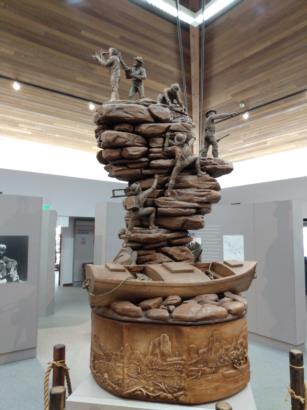
NavList:
A Community Devoted to the Preservation and Practice of Celestial Navigation and Other Methods of Traditional Wayfinding
From: Robin Stuart
Date: 2021 Oct 29, 07:04 -0700
I recently visited the John Wesley Powell River History Museum in Green River, Utah. They have displays on his famous 1869 expedition through Grand Canyon (see https://NavList.net/m2.aspx/Astronomical-Observations-1869-Expedition-through-Grand-Stuart-sep-2020-g48707) and the subsequent one in 1871-72. There is a reproduction of one of his boats, the No Name, that was wrecked quite early on. A centrepiece of the exhibit is this sculpture showing one-armed Powell adopting a noble stance as he takes sextant sights. Unfortunately in reality he would have been hunched over looking downward into a mercury artificial horizon but that wouldn't look nearly as heroic. There are problems with the sextant as well. The telescope is horizontal but the arc is not symmetrical about the vertical.
This got me wondering why Powell used a sextant at all and not a theodolite. Apparently Lewis and Clark did as well. A theodolite would have been much easier for a one-armed man to use and you don't have to mess with an artificial horizon. Was it a question of portability or availability? Does any Navlister have insights? Of course you can shoot lunars with a sextant but not with a theodolite.
Robin Stuart







